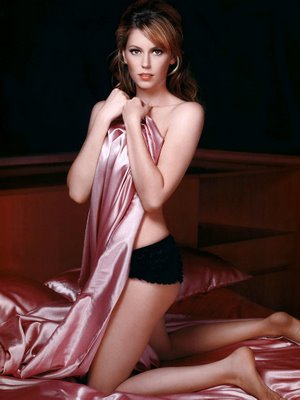
16. That Hideous Strength by CS Lewis
Best known for his Narnia novels, CS Lewis also wrote a trilogy dealing with visiting other planets—well the first two books did. The third was about preventing the evil forces of industrialization and progressive thought from taking over England. It was also grossly misogynistic. It seems Lewis was a big fan of the “women belong in the kitchen” mindset. For all its occasional stodginess and backwards, it is, at times, still a rousing piece about the difficulties of modernity, and the damage it can do the world around you.

15. The Handmaid’s Tale by Margaret Atwood
Wow, can you get more polar opposite of CS Lewis than Margaret Atwood? Despite her protestations of not writing science fiction, her story of a dystopian future where almost all women are infertile is most assuredly of the genre. Set in a future where disease and radiation have reduced fertility to a minimum, and a fascist military theocracy has taken over America (or at least part of it). Brutal in its critique of evangelist Christianity and their view on women, Handmaid’s Tale is a harrowing read at the best of times. In it, women have essentially been reduced to chattels, and the few fertile ones assigned to high-ranking military men in order to give them children.

14. The Sword of Spirits trilogy by John Christopher
While perhaps not as well known as some, John Christopher (the pen name of Samuel Youd) wrote a fantastic trilogy of young adult novels, set in a far future where the world has reverted to a feudal society after a global ecological disaster. This was the same pen name under which Youd wrote the excellent Tripods trilogy, but in my opinion the Sword of Spirits remains a greater work. His world building and subtle hints at the past are unparalleled. It’s not even hinted at for most of the first novel, instead just stranding you in what seems to be a standard fantasy stereotype.

13. World War Z: An Oral History of the Zombie War by Max Brooks
This novel, combined with Brooks’ Zombie Survival Guide are all you need to face the inevitable zombie apocalypse. They’ll teach you well. While the survival guide was exactly that, WWZ was presented as an oral history, an account taken for the UN by the survivors of the horrors of zombies. Brooks did a huge amount of research for this novel, and approached it as a realistic governmental, technological and political take on what would happen if the dead really did rise. It is, without a doubt, an utterly terrifying concept, and Brooks approaches it with aplomb, showing us what a world partly overrun by the risen dead would be like.

12. V for Vendetta by Alan Moore and David Lloyd
I’m sure by now everyone’s seen the movie version of this classic comic, and I hate to sound like Comic Book Guy, but the graphic novel was far, far superior. Where the movie was an argument for democracy against fascism—hardly a contested view; the comic was an argument for anarchy. And not the daft 12 year old kid, but actual, well realized anarchy, involving the destruction of the Government in order to build a new society. It was radical and probing. The novel also had to cut many of the more interesting minor characters and smooth over the development of others. An obvious example is the character of Evey, who in the movie started as a strong independent women. In the comic, she was a terrified teenager, who only gained self-confidence through V absolutely destroying her spirit first.

11. Neuromancer by William Gibson
Lets just throw all of Gibson’s cyberpunk in here, shall we? He could easily take half the list otherwise. Neuromancer was seminal in the establishment of the sadly defunct cyberpunk genre, the cold war era view of the future as a dirty high tech shithole where everyone’s a bastard. Not quite sure why people don’t still think that way. Anyway, Gibson famously wrote Neuromancer on a typewriter, which is more than a touch ironic. With this novel he explored artificial intelligence, virtual reality, urban sprawl, genetic engineering, and generally gave people the heebie jeebies about the future. It also has possibly the most famous opening sentence in modern literature: “The sky above the port was the color of television, tuned to a dead channel.”

10. Do Androids Dream of Electric Sheep? by Philip K. Dick
What I said before about Gibson taking up the entire list? Ibid for Dick. Fueled by drugs, paranoia, hallucinations and excellent writing he crafted many a world populated by police states and extreme surveillance. Androids is one of the better known ones, if only because the excellent Blade Runner was based on (part) of it. In a world where almost all animals are extinct and humans are radiation damaged, society comes to rely on empathy as the holiest of human traits. Eventually it becomes the only way to tell humans from increasingly advanced, but always heartless, androids. It’s a heady take on what it means to be human, and the nature of self.

9. The Book of The New Sun by Gene Wolfe
I’ve waxed lyrical about the Book of the New Sun before, and I’m not going to hesitate to do so again. Wolfe’s four volume future history is without a doubt one of the most under-appreciated works of modern science fiction. Its use of neologisms based in existing language structure, the imperfect narrator, and the incredibly detailed but only ever vaguely explained world all combine into an amazing story. The conceit of the entire quadrilogy being a diary cast back into time from the distant future is a device I’ve never seen used elsewhere. The world Wolfe constructs is filled with an amazing details which are only ever mentioned in passing, as if everyone should know them. It’s a planet where miners dig up old technology instead of minerals. Or were an entire mountain range has been carved up so that every peak commemorates a dead ruler. It’s one of the few pieces of science fiction that I know of that’s had entire books dedicated to its analysis. A magnificent series of novels that are worth getting hold of.

8. A Canticle for Leibowitz by Walter M. Miller, Jr.
Another post-nuclear novel (wow, sensing a trend here?), set in the 26th century (and beyond) about an order of monks attempting to save what remains of humanities learning and technology, by keeping and transcribing books. Over the course of a thousand years, from the anti-intellectual backlash following the nuclear war, through a new enlightenment, and to the onset of nuclear holocaust again, the priests of the Albertian Order of Leibowitz struggle to preserve and protect knowledge they only barely understand. It mulls over symbolism and themes of the circular and repetitive nature of history. Alphas and Omegas, A’s and Z’s. He also spends considerable time mulling over the differences between secular and religious institutions, as well the separation of church and state. It’s definitely an example of post-WWII/Cold War era fears about the future, but manages to remain undated.

7. Fahrenheit 451 by Ray Bradbury
Bradbury’s dystopia of book burning and universal censorship was written in an attempt to communicate how he thought television would destroy literacy, and the damaging effects of censorship. The novel is focussed on literal book burning, and the censorship and suppression of literature is often brought up as the theme of the book, but in later interview Bradbury maintained it was actually that television would remove all desire for people to read, and gain knowledge. That the populace themselves would support the destruction of books, and be happy to reduce their knowledge to factoids without context. Wow, oddly prescient. Luckily the internet has us reading large amounts of text every day, even if it just is “lol noobz!”.

6. I Am Legend by Richard Matheson
The novel, not the shitty Will Smith movie. The movie pissed me off immensely, as it completely missed the point of the goddamn story. Matheson’s story was about vampires, not freaking zombies. It was brutal, misogynistic, and bitterly, bitterly sad. Robert Neville is possibly the only uninfected human being left on earth, who struggles to survive in Los Angeles, venturing out during the day, and dealing with his alcoholism, regrets and rampaging vampires at night. A big chunk of the novella is his slow and methodical learning of science so that he can understand what causes the vampirism. As tempted as I am to spoiler the novel’s end (and the title’s relevance), lets just say it’s much better than Will Smith’s version, and puts an excellent spin on monster myths.

5. Brave New World by Aldous Huxley
I’m sure by now everyone’s read Huxley’s far future novel of constant orgies, drugs and television. Huh, that actually sounds kinda nice doesn’t it? Well, apart from the sleep learning, rigid caste structures, and complete removal of reproductive rights. Henry T. Ford is worshiped, and his views on production and the assembly line extend to human beings as well. It’s a brutal critique of a thoughtless society, obsessed with consumerism and sex rather than anything deeper, and one that views any permanent connection between people as bordering on pornographic. Considering it was written in 1931, it seems quite prescient (as much good dystopian fiction does), and stands as a self-inflicted counter-point to the rigid dystopia of our next entry…

4. Nineteen Eighty-Four by George Orwell
While Brave New World cast the horrific future as a soporific world where everyone chose their own downfall by caring more about pleasures of the flesh than their fellow man, 1984 was the opposite—a totalitarian dictatorship enforced by constant surveillance, propaganda, and jackbooted thugs. Often taken as an anti-communist rant, 1984 is a warning about the dangers of totalitarianism, regardless of its origins. It’s such a pervasive view of a dystopian future, that so much of our lexicon to deal with the concept is drawn directly from this novel: Orwellian, Big Brother, Newspeak. Without 1984, what else would we have to compare Governments to when they did something we slightly disagreed with?

3. A Clockwork Orange by Anthony Burgess
There are two ways to read Clockwork Orange: you can either look at the glossary explaining the combination of russian, english schoolboy and constructed slang every five seconds, or you can just read it through, and hope to pick up the vocabulary as you go. Sure Burgess was a pompous windbag, but he also crafted an excellent tale of drug abuse, ultraviolence, and aversion therapy. This is one of the few situations where I’ll recommend the film as being as excellent as the novel, as it was one of Kubrick’s finest—except in one regard. American versions of the novel printed before 1986 were missing a final chapter, which Kubrick wasn’t aware of. In it, Alex grows tired of violence and drugs, and decides to settle down and start a family with a normal job. While it may sound like a cop out ending, it focuses far more the banality of evil, and how people who do utterly reprehensible things in their early days can become functional members of society.

2. The Road by Cormac McCarthy
There’s bleak, then there’s freaking Cormac McCarthy. McCarthy boils down the essence of a post-apocalyptic dystopia to its bare bones, completely omitting almost all details. There’s a father and son, who are never named. There was a nuclear disaster, and almost all plants and animals are dead, with humans mainly reduced to cannibalism. They’re trying to get somewhere warmer (and hopefully better) before winter hits, and the father is slowly dying of radiation poisoning. While the ending has the slightest possible glimmer of hope, the rest is just ash filled skies, storms and people torturing and eating one another. For all its stark bleakness, it still won the Pulitzer Prize in 2007, which should give you an indication of its pedigree.

1. The Diamond Age, or A Young Lady’s Illustrated Primer by Neal Stephenson
It’s hard to classify any of Stephenson’s tomes without just sighing, shrugging your shoulders, saying “It’s Neal Stephenson” and preparing to slog through hundreds upon hundreds of pages. And you know what? It’s always fucking worth it. Stephenson’s post-cyberpunk love letter to Victoriana, odd social structures, nanotech, and—most importantly—learning is enough to make anyone want to go out and make textbooks. Yeah, that’s how damn good it is, it makes you want to show people how to learn. It’s impossible to heap enough praise on Stephenson, and his nuanced critiques of the interactions of societies. So…just…get the book. Read eat. Savor it. Let it dissolve into you, and absorb it. It’s worth it.















































































